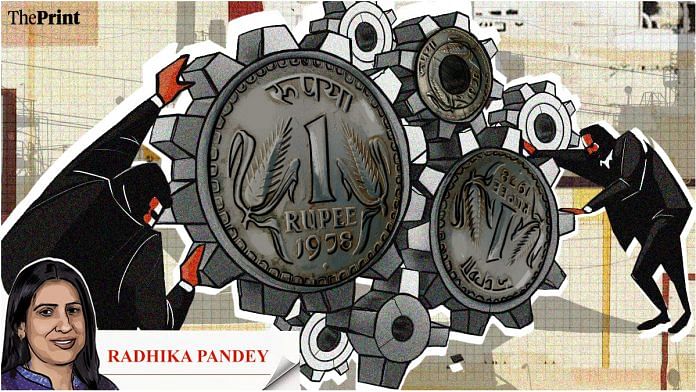In its recently released monthly economic report, the finance ministry expressed concern about the re-emergence of the twin deficit problem in the economy due to higher commodity prices and rising subsidy burden.
While duty cuts and rise in subsidy have raised the possibility of deviation from the budgeted fiscal deficit, rise in crude oil and commodity prices amid a persistent sell-off by foreign investors may cause the deficit on the current account to rise.
The government will have to do a tough balancing act between maintaining growth and macroeconomic stability by keeping fiscal and current account deficits within manageable limits.
Hit to fiscal deficit
The budget had projected a fiscal deficit of 6.4 per cent to GDP for the current financial year. The geo-political conflict and the consequent supply side disruptions have caused an upside risk to the fiscal deficit. The cut in excise duties on petrol and diesel and higher subsidy allocation for fertilisers to cushion the impact of rise in international prices pose a risk to the budgeted fiscal deficit.
A rise in fiscal deficit (excess of expenditure over revenue) would necessitate higher borrowings by the government. Higher borrowings by the government would absorb a higher portion of savings, which could have been used by the private sector for its own investment. Higher borrowings by the government will also push up interest rates, which would adversely impact private sector investment.
At a time when the government is focussed on capex spending to pump-prime growth, the only way to trim the fiscal deficit is to keep a lid on the non-capex expenditure.
Also Read: Weaker rupee, higher inflation — Why US Fed raising rates is more bad news for Indian economy
Surge in current account deficit
The ongoing war has led to a sharp rise in prices of crude oil and other commodities. India imports almost 85 per cent of its domestic crude oil requirements. Sharp rise in import prices will widen India’s current account deficit. A wider current account deficit will put a downward pressure on the rupee as the demand for dollars will increase. A weaker rupee will accentuate the risk of imported inflation.
As a net importer of oil and other commodities, while India traditionally has a current account deficit, high capital inflows have allowed it to finance its current account deficit. But over the last six months, foreign portfolio investors have also pulled out a significant amount of money from the capital market, making India’s external sector more vulnerable.
The aggressive tightening by the US Fed is causing the US bond yields to rise, resulting in continuous FPI sell-off. For FY 22, India’s current account deficit was at a three-year high due to higher global commodity prices and recovery in economic activity. It is expected to widen further to 3 per cent of GDP.
Twin deficit & the taper tantrum episode of 2013
Twin deficits increase the vulnerability to external shocks. India was among the worst hit countries when the Federal Reserve slowed down bond purchases in 2013, known as the taper tantrum.
The indication by the then Fed Chair Ben Bernanke that the Federal Open Market Committee (FOMC) might soon start to slow down its bond purchases triggered a wave of capital flight from emerging economies — particularly from South Africa, Brazil, India, Indonesia and Turkey — dubbed the “fragile five” due to their high current account deficits and dependence on inflows of foreign capital.
These capital outflows put pressure on the rupee. India was one of the worst-hit due to its underlying macro-vulnerabilities.
Policies post the global financial crisis
During the global financial crisis of 2008, India’s economy was part of the global slowdown owing to its trade and financial linkages with the rest of the world. India’s policy response post 2008 crisis focussed on reviving growth, but at a cost to macroeconomic stability.
The government announced a coordinated monetary and fiscal policy package in 2008-09 to kickstart growth. For example, the government introduced fiscal stimulus in the form of tax cuts and increased expenditure to boost consumer demand. The Fiscal Responsibility and Budget Management (FRBM) Act, 2003, (according to which, the government is required to follow fiscal prudence to reduce its deficits to a target rate), was suspended in 2009 in order to accommodate the stimulus policies.
On the monetary side, the Reserve Bank of India introduced measures, such as rate cuts, to boost liquidity and ease credit in order to boost investment. The rate cut cycle continued till March 2010. Fiscal spending alongside low interest rates resulted in higher inflation and imports. The rise in imports resulted in deterioration of the current account. The policy which focussed on enhancing growth resulted in a neglect of macro stability.
Focus on macro-stabilisation
As inflation becomes more entrenched, a calibrated monetary policy normalisation is necessary to anchor inflation expectations. On the fiscal front, while some measures would have to be taken to mitigate the impact of rising prices, the government needs to come up with a glide path for fiscal consolidation.
While the government has set a target of attaining a fiscal deficit of 4.5 per cent of GDP by 2025-26, a roadmap to achieve this target should also be specified. Sound macro-stabilisation requires outlining debt and deficit reduction targets for the next few years. Market adjustment of rupee to rein in the current account deficit should be a part of the macro-stabilisation strategy.
Radhika Pandey is a consultant at National Institute of Public Finance and Policy.
Views are personal.
Also Read: 5 factors will shape Indian economy in 2022, and you can be cautiously optimistic despite Covid






